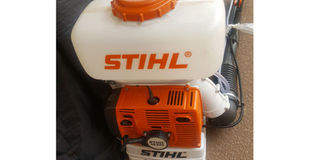Backpack sprayer eases garden work

The backpack sprayer is built in a way that the carrier is separate from the engine. Photo by Desire Mbabali.
What you need to know:
A farmer might need the blower to blow off dew or water on flowers – for people who grow flowers. It can also be used to blow dust off fruit trees and to spray pesticides on small trees or fruit trees, writes Desire Mbabaali
If you are a fruit farmer or have a small tree farm, this could be what you need for spraying. Unlike a hand pump sprayer that has a lower thrust, pressure and reach, the engine driven backpack sprayer does better with more pressure, reach and with less work.
Major parts
The container: This is where the pesticides is kept. Below it is a two-stroke engine with a fuel tank just below it, where petrol and oil are poured for use, since the engine is a two-stroke.
In front of all these is an adjustable support harness that is used to carry the machine like a backpack, from where, one can use the spray.
On the side, stretching out is an arm with a multifunction one-hand joystick-style control handle that provides excellent control over rate and range of spray, where all controls during the spraying process are done.
The arm is pipe shaped from which air is blown out and does the spraying. It is easy to use with a sprayer.
It is also a multipurpose machine that can be used as a sprayer and a blower at the same time.
A farmer might need the blower to blow off dew or water on flowers – for people who grow flowers. It can also be used to blow dust off fruit trees and to spray pesticides on small trees or fruit trees. However, because of the much pressure the machine has, it cannot be used on fragile crops such as tomatoes, and other vegetables.
Application
Put the contents you intend to spray into the tank that is on top of the machine and close the lid tightly. Light up the engine by using a starter and eventually, lift the sprayer like a backpack to your back using the straps.
Make sure the sprayer is comfortable on your back before you start spraying. The equipment was built in a way that the carrier is separate from the engine so that the farmer is protected from vibrations.
While spraying, the pipe-like sprayer should be tilted at around 30 degrees up for consistent flow.
More details
They also come in different sizes; of small, medium and large, with the medium size at Shs3.3m.
The STIHL SR 200 engine driven backpack sprayer features a low-exhaust-emission, fuel-efficient engine that delivers up to 20 per cent better fuel economy than most conventional two-stroke engines.
The equipment has an 8.5 kilogrammes weight without the liquid, a displacement of 27.2cc. Its engine power is 0.8Kw and the container capacity is 10litres.
Its maximum spray range is 29.5 feet, horizontally and 18feet vertically. Its air velocity is 81m/sec and the air volume of 580 m3/h (with tubes).
The challenge with the equipment is, however that for a fairly large garden and for a large-scale farmer, they will have to make a refill very often because of the low capacity (i.e. 10, 20 and 30 litres) that the container can contain. This therefore, means that while using it, the water or pesticide source needs to be kept in close proximity.
Otherwise, check out for this sprayer from STIHL Holdings Uganda.
Spraying tips
Planning
Chemicals play a vital role in agriculture but it is important to determine if there is a need to spray. If a decision to spray is reached then setting time aside to adequately plan any spray programme is vital to ensure chemicals are used safely and responsibly.
Read the label
Read the product label thoroughly and understand all the requirements and advice to ensure the job is done as effectively and safely as possible. Resistance of diseases, pests and weeds to agricultural chemicals is a naturally occurring phenomenon that can be made worse by poor chemical use practices, so is essential for farmers to manage.
Know your equipment
Ensure your equipment is set up correctly and accurately calibrated to ensure the required amount of chemical reaches the target otherwise you are wasting time and money.
Keep records
Recording chemical use details is a legal requirement and vital for traceability in production systems and ongoing management of chemical use in terms of monitoring efficacy and rotations of chemical groups to prevent resistance build up. There is no specified format for record keeping, only required details. The best way to ensure records are kept is to develop your own system which suits your business practices.




